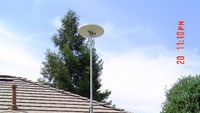Remaining DTV hurdles include antenna installation

With Wilmington, NC, stations successfully making the switch to digital transmission, over-the-air reception is once again in the news, but the full story has not been written. Difficult multipath problems in urban areas and mountainous regions will continue to limit universal coverage in digital, as they have in analog.
A Consumer Reports survey taken earlier this year found that 15 percent of Americans live in households that rely exclusively on over-the-air signals. Among these TV viewers, however, those that can’t get analog service via a terrestrial antenna won’t be able to receive a digital one either, according to a company that installs outdoor antennas on homes.
Groups like the NAB and the Association of Public Television Stations (which represents public stations) say that the 22 million American households that rely upon terrestrial television will either move slowly to adopt digital TV sets or subscribe to cable or satellite services.
Anticipating the DTV transition, The Signal Group, which sells converter boxes, antennas and other electronic devices, began developing relationships with installation companies about four years ago and now has them ready to go to work. They’ve also set up a Web site and a phone number for consumers to call and get help.
However, there’s no panacea here.
“If you live in remote parts of the country, you’re probably not going to be able to pick up a signal,” said Jerry Chapman, president of The Signal Group, in Novi, MI. “There’s not a lot I can do about that.”
Using a business model he designed, Chapman’s company doesn’t install antennas themselves, but coordinates with other companies — many that currently install dishes for satellite TV service — and have so far completed several hundred antenna installations. They consider themselves a “service aggregator” as well as an equipment supplier, which has sold thousands of antennas and converter boxes.
The professional video industry's #1 source for news, trends and product and tech information. Sign up below.
Amid so much pent-up demand, however, Chapman said they’ve had some issues with installers. Many are experienced in installing satellite dishes on homes but are not as familiar with what is involved with mounting traditional TV antennas.
For Chapman, the most frustrating part is babysitting the installation remotely and solving a problem when it comes up, which often means spending time on the phone with both the customer and the installer.
“It’s not rocket science,” he said, “but there is a learning curve that has to be completed before an installer can knock out two or three in a day. For them, the real money is installing as many as you can as quickly as possible.”
Chapman said the installation service has value for people who either can't or won't get up on their roof. “In the case of nursing homes and hospitals, we fell like we’re doing some good for the community.”
With limited crews and resources, Chapman’s said the company couldn’t install an antenna in every zip code. “I can’t reach every one who wants an antenna; there’s not enough installers at the moment, but we’re working hard to accommodate as many people as we can.”
The installers themselves have a big say in how many people are serviced. Some of the installers Chapman works with are willing to go the extra mile. “We coordinated one the other day where the installer traveled 80 miles to do the job,” Chapman said. “So we hit a lot of areas and do have some reach.”
Getting around the varied community association restrictions might be the biggest hurdle to the DTV transition. Many regions of the country have strict rules about what consumers can mount on the roof of their house. For Chapman and his team, it’s an extremely time-consuming issue to get clearance from these homeowner groups.
“Some of my sales reps will e-mail these groups information about the government mandate, which, once they realize they have to allow home-owners to install an antenna, changes a few minds.”
Chapman said he has had informal conversations with a few broadcasters around the country, but for the most part, stations don't seem interested in speaking with him. “I don't have a great relationship with them. The conversations I have are few and far between, which is surprising because we’ve been working on the digital conversion for about five years and know what we are talking about. This is a big year for us.”
Chapman predicts that not every one of the millions of anticipated homes will have the type of antenna they want installed by Feb. 17, but he’s “confident we’re doing the best we can; our resources are limited and we’re the only one doing it, so it will take time. But we will get there.”
For more information, visit http://www.antennaistalls.com or call (866) 374-4625.
